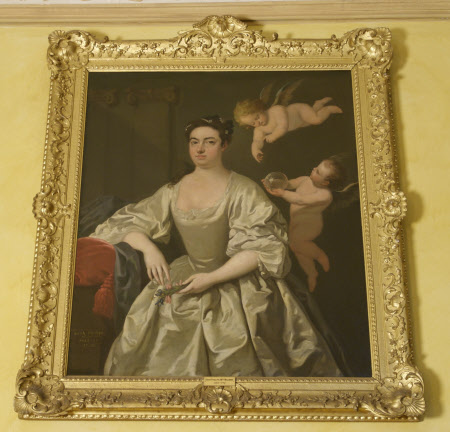Edith Phelips, Mrs Carew Mildmay (1694-1772)
Andrea Soldi (Florence c.1703 - London 1771)
Category
Art / Oil paintings
Date
1750 (inscribed)
Materials
Oil on canvas
Measurements
1270 x 1016 mm (50 x 40 in)
Place of origin
London
Order this imageCollection
Montacute House, Somerset
NT 597913
Summary
Oil painting on canvas, Edith Phelips, Mrs Carew Mildmay (1694-1772) by Andrea Soldi (Florence c.1703 - London 1771), inscribed with the name of sitter and the date 1750. A portrait of a young woman, three-quarter length, standing slightly to the left and gazing at the spectator, her dark-brown hair dressed with pearls with one ringlet on her right shoulder. She is wearing a white satin dress with full sleeves tucked to the elbow, her right arm resting on a red tasselled cushion on a pedestal on the left, flowers in her left hand. Two putti are flying on the right, the lower one holding a glass bubble with both hands. Two pilasters at the left, with nothing to support. Third daughter of Sir Edward Phelips III (1638-1699) and Edith Blake (1662-1728), married Carew Hervey Mildmay MP (1690-1784) the younger brother of the 1st Earl Fitzwalter, as his second wife in 1744. They had two still-born children.
Provenance
On loan from the Phelips family since 1931; purchased with the aid of the National Heritage Memorial Fund and the V&A Museums and Galleries Commission Purchase Grant Fund in 1989.
Credit line
Montacute House, The Phelips Collection (The National Trust)
Marks and inscriptions
Recto: Inscribed on bottom left: Edith Phelips. / afterwards / Mildmay / 1750. Recto: Gilt tablet affixed to bottom of frame, inscribed in black:
Makers and roles
Andrea Soldi (Florence c.1703 - London 1771), publisher
References
Montacute House, Somerset, 1976 [The National Trust; Dudley Dodd] 1976, THE GREAT HALL Portraits Loaned by Mr David Phelips, from (left to right). Edith Phelips (1693-1772). Inscribed with date, 1710. Sister of the above. Wife of Carew Milday [sic]. Can the airborne putti be intended to represent her stillborn children?" Montacute House, Somerset, 1976 [The National Trust; Dudley Dodd] 1976, An Illustrated Souvenir, Shown hanging above the fireplace in the Great Hall. Montacute House, Somerset, 1991 [The National Trust; Malcolm Rogers] 1991, p.56 "THE GREAT HALL WEST WALL (FACING WINDOWS): Edith Phelips, Mrs Carew Mildmay (1694-1722) The youngest daughter of Sir Edward Phelips (1638-99) and Edith Blake, she married Carew Hervey Mildmay, younger brother of the 1st Earl Fitzwalter, as hes second wife in 1744. The putti in the portrait may represent still-born children, and one carries a bubble emblematic of the frailty of life. The Florentine Soldi came to London in 1736, and twice painted Mildmay, s well as doing work for his brothr. The putti show the influence of another Italian artist, Amigoni, who had also worked for Lord Fitzwalter. Andrea Soldi (c.1703-71, 1750." Montacute House, Somerset, 1997 [The National Trust; Malcolm Rogers] 1991, revised 1997 , p.57 "THE GREAT HALL WEST WALL (FACING WINDOWS): Edith Phelips, Mrs Carew Mildmay (1694-1722) The youngest daughter of Sir Edward Phelips (1638-99) and Edith Blake, she married Carew Hervey Mildmay, younger brother of the 1st Earl Fitzwalter, as hes second wife in 1744. The putti in the portrait may represent still-born children, and one carries a bubble emblematic of the frailty of life. The Florentine Soldi came to London in 1736, and twice painted Mildmay, s well as doing work for his brothr. The putti show the influence of another Italian artist, Amigoni, who had also worked for Lord Fitzwalter. Andrea Soldi (c.1703-71, 1750." Montacute House, Somerset, 2004-2006 [The National Trust; Malcolm Rogers] 2000, revised 2004, reprinted 2005, 2006, p.45 "THE GREAT HALL WEST WALL (FACING WINDOWS): Edith Phelips, Mrs Carew Mildmay (1694-1722) The youngest daughter of Sir Edward Phelips (1638-99) and Edith Blake, she married Carew Hervey Mildmay, younger brother of the 1st Earl Fitzwalter, as hes second wife in 1744. The putti in the portrait may represent still-born children, and one carries a bubble emblematic of the frailty of life. The Florentine Soldi came to London in 1736, and twice painted Mildmay, s well as doing work for his brothr. The putti show the influence of another Italian artist, Amigoni, who had also worked for Lord Fitzwalter. Andrea Soldi (c.1703-71, 1750."

